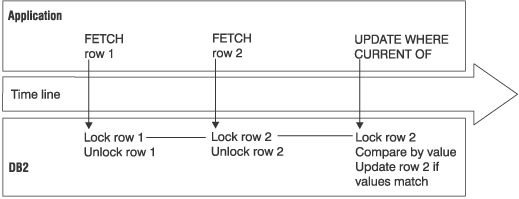The ISOLATION (CS) option
The ISOLATION (CS) or cursor stability option allows maximum concurrency with data integrity. Under the ISOLATION (CS) option, a transaction holds locks only on its uncommitted changes and on the current row of each of its cursors.

- For table spaces created with LOCKSIZE ROW, PAGE, or ANY, a change
might occur even while executing a single SQL statement that reads
the same row multiple times. In the following statement, data read
by the inner SELECT might be changed by another transaction before
it is read by the outer SELECT.
Therefore, the information returned by this query might be from a row that is no longer the one with the maximum value for C1.SELECT * FROM T1 WHERE C1 = (SELECT MAX(C1) FROM T1); - Another case is a process that reads a row and returns later to
update it. That row might no longer exist or might not exist in the
state that it did when your application process originally read the
row. That is, another application might have deleted or updated the
row. If your application is doing non-cursor operations on a row under
the cursor, make sure that the application can tolerate "not found" conditions.
Similarly, assume that another application updates a row after it is read by your application. If your application returns later to update the row based on the read-in value, your application erases the update from the second application.
Therefore, if you use ISOLATION(CS) with update, your process might need to lock out concurrent updates. One method is to declare a cursor with the FOR UPDATE clause.
For packages and plans that contain updatable static scrollable cursors, ISOLATION(CS) enables DB2® to use optimistic concurrency control. DB2 can use optimistic concurrency control to shorten the amount of time that locks are held in the following situations:
- Between consecutive fetch operations
- Between fetch operations and subsequent positioned update or delete operations
DB2 cannot use optimistic concurrency control for dynamic scrollable cursors. With dynamic scrollable cursors, the most recently fetched row or page from the base table remains locked to maintain position for a positioned update or delete.
The two following figures show processing of positioned update and delete operations without optimistic concurrency control and with optimistic concurrency control.


Optimistic concurrency control consists of the following steps:
- When the application requests a fetch operation to position the cursor on a row, DB2 locks that row, executes the fetch operation, and releases the lock.
- When the application requests a positioned update or delete operation
on the row, DB2 performs
the following steps:
- Locks the row.
- Re-evaluates the predicate to ensure that the row still qualifies
for the result table.
